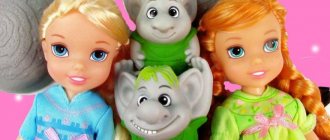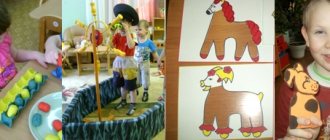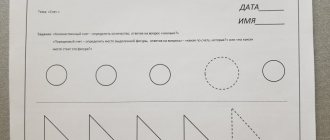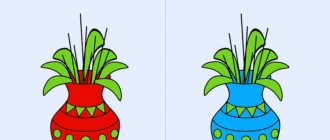Didactic game "Caterpillar"
Goal: to develop motor skills of the fingers through actions with objects, sensory perception, logical thinking
Game option: “Continue the row.”
Didactic manual “Finger dry pool”
Dry pool - used for simultaneous active stimulation on various points of the hands, fingers, palms; sensorimotor development, the formation of basic sensory standards: shape, size, material, weight, sound; fostering perseverance and patience in work; relieving emotional stress. It’s very simple to make: fill the Kinder Surprise capsules with various fillings (rice, peas, beans), cover them with thermal film for Easter eggs, put them in a small deep plastic container, and hide the Kinder Surprise toys at the bottom.
Ask your baby to look for various small objects or toys in the dry pool. By plunging as deeply as possible into the filler, the child’s hands are massaged, the fingers become more sensitive, and their movements become coordinated.
This manual can be used in music classes.
Didactic game “Beads from salt dough”
Goals:
- strengthening and development of fine motor skills, hand-eye coordination;
- developing the ability to combine colors;
- development of concentration; development of perseverance, accuracy, children's creativity, a sense of beauty in one's own work and the work of other children;
- learning how to work from a sample and create your own product.
This benefit can be done by the child himself, with a little help from an adult. Dough modeling really helps develop a child's motor skills. After all, a baby can change the shape of an object from a spherical shape to a square or triangular one. And, taking a piece of dough in his hands, he can feel its weight, heaviness and viscosity.
Description of the preparation of the manual:
Prepare salt dough (mix 1 cup of “Extra” salt, 1 cup of flour, 0.5 cups of cold water, leave for 2-3 hours in the refrigerator), form balls, make holes in them using a cocktail straw, leave until completely dry. The beads are ready!
Didactic manual “Place the eggs in your houses”
Goals:
- develop the ability to distinguish and correctly name the 4 primary colors;
- learn to combine a testicle with a cell, perform correlating actions (color guide); act purposefully, sequentially: from left to right, without skipping cells; develop fine motor skills of the fingers.
Description of the tutorial: Paint the cells of the egg container with the main colors and varnish them. We tie the Kinder Surprise capsules in the appropriate color.
The result is a bright and beautiful manual.
Children must arrange the eggs into houses according to their color.
If possible, name the color of the eggs and the color of the houses.
Didactic manual “Place the pencils in cups.”
Goals:
- develop the ability to distinguish colors;
- learn to combine a pencil with a glass; act purposefully, sequentially: from left to right; develop fine motor skills of the fingers.
Description of the tutorial: Cut out rectangles and pencil shapes from ceiling tiles. We cover the rectangles to the middle with squares of self-adhesive film of different colors. We paste the pencils with the corresponding colors. Fast, beautiful, economical!
"Tactile Box"
The tactile box is a teaching tool designed for young children.
Made from an ordinary shoe box, beautifully decorated with self-adhesive paper.
The box is filled with pieces of fabric of different textures: wool, fur, silk, guipure, etc. It also contains small objects: pebbles, soft toys, ribbons, zippers, laces, etc.
Children examine all the objects in the box with great interest with their hands.
The teaching aid “Tactile Box” helps children, using touch, to explore the world around them from a completely unusual point of view.
To ensure that kids don’t lose interest in the box -
From time to time you have to update the contents of the box and come up with different fillers.
The tactile box can be filled with objects that have completely opposite properties, for example: sandpaper, an iron key, pieces of foam rubber, a porcelain figurine, etc.
This manual can be used in direct educational activities, as well as in children’s independent activities (provided that it contains items that are safe for the life and health of children).
Didactic game “Find the extra traffic jam”
Means: corks of different colors and sizes.
Goal: development of logical thinking.
- Consciousness of an emotionally positive mood.
- Development of interest and motivation to action.
- Introducing sensory standards: getting to know different
- Properties of an object: size (large, small), shape (circle), color; developing the ability to alternate objects by color and size.
- Development of the motorized hand: developing the ability to perform actions with objects.
- Forming the skill of jointly completing a task: developing cultural communication skills;
- Development of the ability to understand and correctly perform tasks;
- Formation and activation of the child’s vocabulary: development of the ability to look at a picture, name the objects depicted on it, their qualities and actions;
- Development of perception: visual, tactile.
- Development of visual – effective, imaginative thinking, attention, memory, imagination.
Educational game for developing fine motor skills “Feed the piglet” with your own hands
Remedy: a soft toy (pig) and a bottle the size of the soft toy. Get mixed feed - beans, peas, corn flakes, etc.
Why you need to develop fine motor skills
Many people know about the need to develop children's fine motor skills from an early age. However, not everyone understands why this is needed and what such activities are.
Fine motor skills are the ability to perform precise movements with the hands and fingers. It is coordinated by the work of the nervous, muscular, skeletal and visual systems. Its development begins in the first months of a child’s life with looking at his own fingers and hands. Then the baby gradually learns to master them by picking up toys. Motor skills have a positive effect on manual dexterity, the formation of a student’s future handwriting, and reaction speed.
It has been established that the level of development of a child’s speech directly depends on the degree of formation of finger movements. In the human brain, the centers responsible for speech and motor skills are located nearby. Thus, when one area is stimulated, the other is also activated.
Card index of didactic games on sensory education for young children 2-3 years old
Didactic material for sensory education - systematized sets of objects or pictures that give children the opportunity to practice identifying certain characteristics of objects, comparing some objects with others, grouping objects, and solving problems on their spatial arrangement. As cognitive abilities develop, the material becomes more complex.
Learning takes place in a playful way so that preschoolers remain highly motivated to study.
Requirements for educational games:
- safety;
- visibility;
- naturalness of materials;
- brightness and naturalness of colors;
- availability;
- age appropriate.
What is a sensory box?
Sensory boxes are containers with various sensory fillings (liquids, bulk materials, jelly, paste, toys, etc.). This is an extremely useful and multifunctional toy for children of early and preschool age. The baby can feel small objects, pour them in, hide them, and come up with his own story. Playing with a sensory box helps develop a child's fine motor skills, attention, imagination and speech.
It is easy to make a sensory box for a child with your own hands with minimal material costs.
This educational toy can be based on any container: box, container, basin, pan. The main thing is that the child feels comfortable playing with it. Next, the container is filled with various materials (depending on the theme of the sensory box and the age of the child). Usually these are cereals, pasta, pebbles, natural materials, water, jelly, cotton wool, etc. To make it more interesting for your baby, put small toys and tools (shovels and scoops) in the “box”.
Sensory education in children 2-3 years old
In order to purposefully influence the sensory skills of preschoolers, it is necessary to know the main stages of sensory development, be able to diagnose its level and correlate it with age-related characteristics. Among them are the following:
- Getting to know an object through perception through the senses. The child puts it into his mouth, tastes it, feels it, smells it, evaluates its shape and size.
- Formation of skills to correlate the spatial arrangement of objects, connect objects and their parts. The child evaluates the sizes of objects and their relationships. To do this, you need to teach children to put one object into another (games with a pyramid work well), string beads on a cord, and push small objects into various holes. The child becomes familiar with composite objects, with the concept of the whole and parts. Games with large puzzles, cut-out pictures, and construction sets of 2-4 elements will help him with this. At the first stage, the child is able to assemble a matryoshka doll from 2 elements.
- Mastering ways to practically distinguish the properties of objects. A preschooler learns to compare two similar objects through practical actions: putting one on top of the other, the relationship between shape and color. At the second stage, the child is able to assemble a matryoshka doll from 3 elements.
- Formation of manipulative actions with an object based on repeated repetition. After practical manipulations with an object, the child is able to visually correlate the size and shape of objects using only mental operations. He can group objects according to one characteristic, select 3 objects according to a given pattern, and is able to sort objects from smallest to largest. At this stage, the preschooler assembles a five-seater nesting doll.
- Complicating the conditions for performing actions that require correlation according to one of the characteristics. The child groups objects according to several characteristics, is able to correlate 6 or more colors with each other, and visually selects a pair of objects according to given characteristics.
- Using learned actions in solving practical and cognitive problems. The child is able to reproduce acquired knowledge and skills, differentiate the properties of objects, and apply subject standards in solving assigned problems. At this stage, a 3-year-old child can correctly assemble a pyramid of 8 rings in descending order of their size.
Sensory education is a targeted didactic impact on the sensory systems of preschool children, which becomes more complex with each new stage of sensory development. Creating conditions for the comprehensive development of the senses is the task of parents and teachers of preschool educational and developmental institutions.






